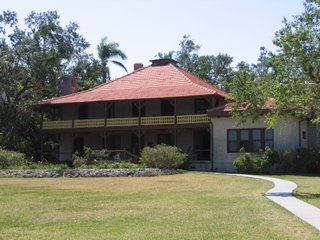 Today was an anomaly: by 1:00 PM my wife and I were done with all the chores we had to do today and had the rest of the afternoon free of any other engagement. The day was beautiful, the temperature in the high 80's and a killer breeze was flowing in from the east, so we got in the car (we got my father-in-law's Lexus 330 for the weekend, since he's out of town) and started driving, determined to go somewhere, anywhere.
Today was an anomaly: by 1:00 PM my wife and I were done with all the chores we had to do today and had the rest of the afternoon free of any other engagement. The day was beautiful, the temperature in the high 80's and a killer breeze was flowing in from the east, so we got in the car (we got my father-in-law's Lexus 330 for the weekend, since he's out of town) and started driving, determined to go somewhere, anywhere.
We took Biscayne Blvd. (US 1) to Downtown Miami, and kept going south until we reached Coconut Grove. We hadn't been to the Grove in almost a year, and as we looked around at all the changes that have taken pladce, we suddenly remembered there was one place right in the Grove that we had been wdanting to visit, The Barnacle Historic State Park. For the last 10 years that we had been visiting the Grove we had seen the sign to the Barnacle, but never really knew what it was cause it was always closed at the times we hung out at the Grove.
The Barnacle is a 115-year old house in the heart of Old Miami, right in front of Biscayne Bay, the oldest house in Miami-Dade still standing on its original site. It was built by Commodore Ralph Munroe, a New Yorker who moved down to the Miami he had fallen in love with in 1877 for the sake of the woman he loved. His wife had contracted tuberculosis and though the hotter climate helped her somewhat, she died in 1881. Monroe returned the year after and opened a hotel on Biscayne Bay, and in 1886 he purchased 40 acres of bayfront property for $400. In 1891 his house was completed, a one-story, solid wood, octagonal structure which he called the Barnacle. In 1908 the whole structure was raised and a new first floor was inserted underneath in order to accomodate the Commodore's new family with his second wife, Miss Jessie Wirth.
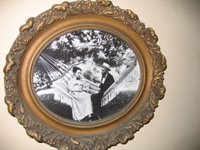
The house has since stood on the same spot, seeing Miami grow, withstanding hurricane after hurricane, including the two most disastrous storms to hit Miami, the 1926 hurricane and Andrew in 1992.
Munroe displayed an incredible foresight more than 100 years ago as well. The Barnacle stood in the middle of the original Miami Hammock, and Munroe only cut a path wide enough for one vehicle in order to preserve the most of the natural habitat as possible. Today, with only 5 acres of the property's original 40 remaining a part of the park, the Barnacle remains one of the few (if not the only) places where the original hammock remains.
The house is incredibly beautiful, too. It is an airy structure with large windows that let in a great amount of light and a wonderful breeze. The first floor is the public area of the house: the living room, the dining room, kitchen and study.


A staircase leads up to the second floor, the original octagonal structure, where bedrooms radiate in all directions. The rooms have been refurbished to show how they looked in the early 1900's, including a baby carriage, baby walker, sowing machine and of course, the beds and dressers.


A large skylight in the middle of the octagon lets the sun shine gloriously inside the house.
 As you look east, out the door that once welcomed everyone into the house, you catch a glimpse of the azure waters of Biscayne Bay and can fully understand how the Munroes fell in love with this house and with this city.
As you look east, out the door that once welcomed everyone into the house, you catch a glimpse of the azure waters of Biscayne Bay and can fully understand how the Munroes fell in love with this house and with this city.

If the house is great, the grounds are simply amazing. The front porch overlooks a long, clear avenue of grass leading to the boathouse and the bay waters.
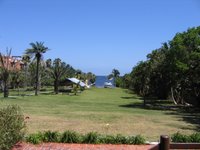
A dried-out coral well stands to one side, once a gate to a fresh water acquifer underneath the house, now a home to spiders and crawling vines.

A winding path leads down to the water where one can see a replica of one of Munroe's original yatch designs moored in a small inlet flanked by patches of mangrove. In the distance you can see the islands of Biscayne Bay and Miami Beach just over the horizon.

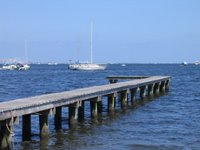
We had a most wonderful day, and left once again amazed at the amount of history that hides in this city that so many simply dismiss as a party central, and incredibly glad that we had become part of that history.
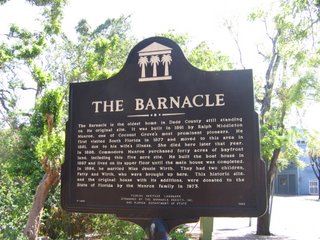

No comments:
Post a Comment